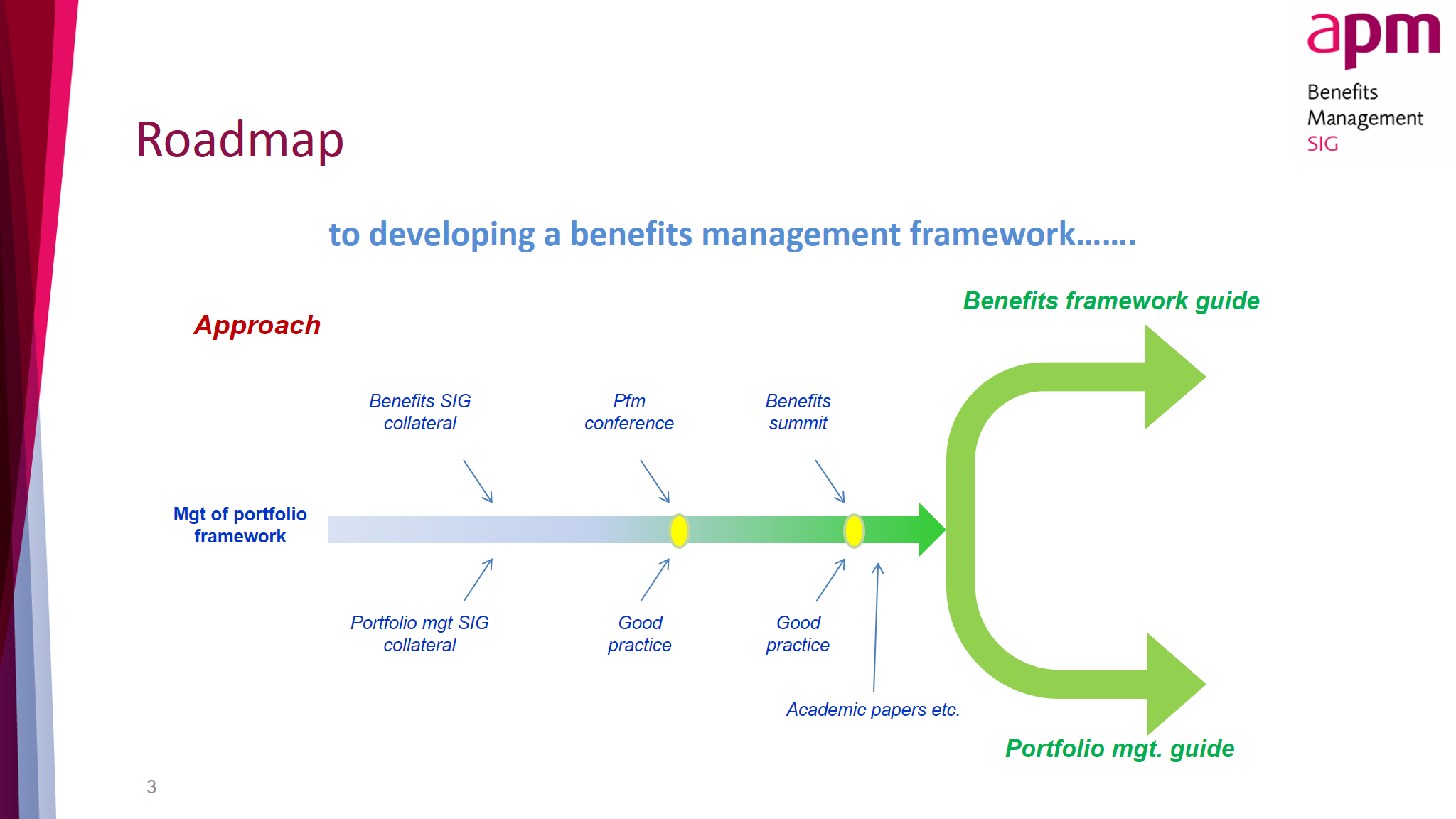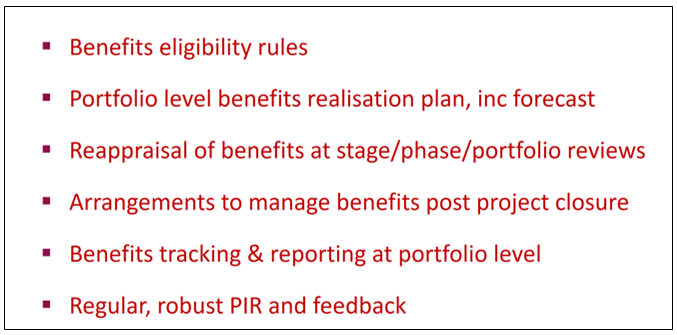Workshop: Portfolio and benefits management framework development
Simon Darby, APM Portfolio Management SIG committee member and Neil White, APM Benefits Management SIG Chair
Introduction
Although no two organisations are the same there are many benefits management capabilities needs that are common to all e.g. governance, benefits identification, benefit measures etc. The accepted solution to standardising and providing a consistent approach to implement benefits management across multiple projects and programmes is to develop a portfolio-level benefits management framework.
The Benefits Management SIG have a project underway to produce a guide to be used by those organisations that wish to create such a framework.
The Portfolio Management SIG have an initiative to produce a Portfolio Management guide!  Collaboration
Collaboration
Our two SIGs have been working together to ensure that we arrive at complementary knowledge products that meet the needs of our respective communities.
Portfolio management is about coordinating all the change that an organisation is going through, and Benefits Management is about keeping the change on target. So, it’s a win-win. Our joint development roadmap is shown below:
 SIG workshops
SIG workshops
Annual SIG conferences [and summits] are a great opportunity to assemble hundreds of years of experience in one place - 287 years in the case of the 2017 Benefits Summit workshop (1).
Workshops were held as an integral part of the Portfolio Management SIG conference [May 2017] and the Benefits Management SIG Summit [June 2017].
The objective of each workshop was to ensure the resulting guides meet the needs of their intended readership by involving practitioners in the creation of content. Each workshop presented the attendees with the topics listed below [which is based on framework criteria taken from ‘Management of Portfolios’]

(1) 287 years’ experience in the case of the 2017 Benefits Summit workshop.
46 people in workshop.
25% with 10 years plus, average 15 years. 25% 5-10 years (7.5 average), 25% 0-5 (2.5) and 25% unknown / not calculated.
Benefits Summit workshop
The BM Summit workshop was designed to be dynamic and innovative, using Mentimeter [audience polling software] to make the best possible use of the time available to capture and share knowledge, experience and ideas within the room, in real time.
The results are available here and can be seen below:
 Simon Darby, APM Portfolio Management SIG committee member
Simon Darby, APM Portfolio Management SIG committee member
A Change Management and Project Portfolio Management specialist with over 20 years’ experience with organisations regulated by the Financial Conduct Authority.
In terms of benefits management Simon has defined and implemented a benefits management framework at NHBC (Largest UK warranty / insurance provider for new homes).
Simon is currently a volunteer with the APM Portfolio Management Specific Interest Group and is supporting this group define a Portfolio Management introductory guide on behalf of the APM.
Simon is an experienced facilitator and has supported the Executive Director Group at NHBC with their strategic prioritisation decision making from 2012 to 2017.
In addition he has managed teams of Project Managers, Programme Managers, Business Analysts and PMO personnel at Barclaycard, Volkswagen Financial Services and NHBC.
N eil White, APM Benefits Management SIG Chair
eil White, APM Benefits Management SIG Chair
Neil is Chair of the APM Benefits Management SIG and a founding member of the APM Enabling Change SIG.
Neil is an experienced Change Manager and strong advocate of Benefits Management in support of strategically driven organisational change. Neil has spent much of his career working in the Aerospace and Defence sector but in recent years has worked in the Transport and Government industry sectors. Neil has a Master’s Degree in Change Management and uses this knowledge and experience to help ensure that Benefits Management activities enable an organisation’s change initiatives to realise the required outcomes.
Hobbies: Gadgets, gardening and of course APM BM SIG.
Appendix
1. Benefits Eligibility Rules: comments & suggestions?
- Need to be signed off at the most senior level & consistent with organisation strategy
- Aligning to Green book guidance, e.g. supplementary guidance on methodology to measuring carbon emissions
- Fit with a pre-defined benefit sets or categories with recognised measurement mechanisms
- Consider the strategic alignment of the benefit identified when considering if a benefit can be added to the portfolio
- Identity corporate level benefits
- How do you avoid double counting of benefits from competing change initiatives?
- Do you allow benefits specific to a project, in other words not contributing to portfolio KPI / benefits?
- Challenge is how to get buy in to benefits for a purely enabling delivery e.g. Infrastructure type projects
- Keep it as simple as possible and as high level - noting metrics may change over time
- Strict eligibility rules - how do these relate to design principles?
- Be clear on what you mean by benefits eligibility. Do you mean benefits eligible to be included in appraisal or benefits eligible for management?
- Benefits that can be aggregated, and benefits that can only be measured at the portfolio level (and only at project level)
- Benefit enablers must be equally as realistic as the benefits i.e. achievable, not ridiculously risk, costly etc.
- Include dis-benefits
- Ensure that the benefits included are measurable
2. Portfolio-level benefits realisation plans: comments & thoughts?
- Plan in a classical sense. Don't over engineer!
- Consistent set of common currencies/KPIs for the portfolio
- Benefits realisation plan developed pan-portfolio grouped by themes rather than project-by-project: synergy and timeline visibility?
- Should the portfolio remit not be to measure delivery of strategic objectives? Programmes track benefits, projects track delivery
- Metrics, ways of measurement and responsibility for measurement during and after the project and programme lifecycles must be defined
- Target stakeholders who will be embedding change to consult on identifying benefits
- Have you got an example of a benefits realisation plan?
- Realism
- Is there a distinction between Benefits Realisation Management Plan and Benefits Realisation Plan?
- Company KPI = portfolio benefits. But most company kpi are about change - need to include benefits about successful d2d operation
- Strategic focus - start with strategic fit analysis....
- Need to be timely - i.e. when is the most appropriate point to measure?
- Accountability is key. Identify who is accountable for the realisation, and that they have agreed to be accountable
- Shouldn't just include overall accountability, but how that accountability is disseminated through the organisation and delivery partners
- Providing ability to track realisation over time across the portfolio and assess the size of the gap between realised and target
- Strict accountability and responsibility
- Clearly defined roles and responsibilities and governance arrangements
- Difference between enabling and realising benefits
- The risk of benefit double counting must be assessed and mitigated
- Link between Transition Management, Change Management & Benefits Management
- Who measures? Subject matter experts not project team for independence. If it's financial, should finance measure it?
- Ensure benefits realisation plans address what needs to change to realise e.g. team sizes, shift pattern, headcount reductions, cancelled licences
- Change behaviour to change thinking to ensure BRM at any level(project/prog/portfolio/strategy) becomes an accepted habit of the organisation
- Plans should address timing of benefits triggers, amount of benefit, and timing of benefit realisation, which may be staggered
- The handover of benefits measurement from the project or programme team to the BAU benefits owners must be part of the plan
3 - Reappraisal of benefits at stage/phase/portfolio reviews: comments & thoughts?
- Appraisal needs to be of whole biz case
- Consider also benefits expected from projects and programmes that are In the portfolio but have not started yet
- Do if anything changes
- How do you deal with projects being in different lifecycle stages whilst trying to look at the portfolio?
- How many organisations in the room do benefit reappraisal?
- Is this a change event? Risk of moving goal posts - measure against original baseline?
- Need to be robust in reappraisals - for example trigger remedial activity
- Portfolio - appraise objectives
- Programme - appraise benefits
- Project - appraise capability
- Portfolio reviews = has strategy changed, remaining budget, benefits already delivered, latest benefit forecasts, new projects
- Reassess baselines and forecasts, including assumptions, risks and dependencies
- Define frequency of reappraisal in benefits plans
- Do software tools help or hinder?
- Do, if anything changes as you do with the rigging on a sailing ship
- Needs to be done in the context of validation of the business case
4 - Arrangements to manage benefits post project closure: comments & thoughts?
- Need to have standardised set of tools and techniques as part of BAU / run the business
- Strong handover rules between SROs and BAU leads
- Optimisation/tracking of benefits should be a programme responsibility during and beyond the closure of a single project
- Ensure that ways of measurement and responsibilities for measurement are in place before project closeout
- Successful embedding of change needs structured handover
- It's not always financial
- Business change is key
- Link to local PI's that further link to KPI's
- Needs to be embedded into BAU
- Tie BAU reporting back to project for change, as well as the BAU dashboard
- Have a system/tool to manage benefits which is distinct from any BAU reporting
- Difficult to separate post-project benefits from BAU changes - if a business metric changes, is this due to the project?
- Ensure roles, responsibilities and governance arrangements are clearly set out at project hand over stage
5 - Benefits tracking & reporting at portfolio-level: comments & thoughts?
- Aligning corporate performance reporting and portfolio reporting
- Categorisation. Must be common across projects and programmes (both categories and calculation methodology) to enable a portfolio view
- Report portfolio level benefits in association with the achievement of strategic objectives
- Transparency and open access to sponsors
- Examples - especially non-financial
- Consider adding benefits reporting into 'day job' reporting
- Identify your audience. Tailor reporting to what they want to see
- Easy aggregation of data and information
6 - Regular robust PIRs & Feedback: comments & thoughts?
- A PIR must be required from all projects and programmes. Portfolio level results should be consolidated and linked to strategic objectives
- Challenging to get people interested in this
- Ensure that key stakeholders are involved or consulted
7 - Please submit your ideas for additional topics for benefits framework
- Accountability
- Addressing projects/programmes in flight where the essential 'early' work re benefits identification and ownership hasn’t been captured
- Align to Risk Management Framework
- Benefit Changes and approach to manage the Change
- Benefits that are additional to the first thought up ones, but could turn out to be valuable
- Challenge process at project level
- Examples - especially non-financials
- Management of collaboration and partnering
- Ownership
- Ways of measuring and tracking qualitative benefits and social benefits
- 3 distinct levels of practical tasks: Project, programme and portfolio level with RACI
- Innovation and unexpected benefit
Write-up by Hugo Minney
Benefits Management SIG committee member
Back to Benefits Summit 2017 mainpage
